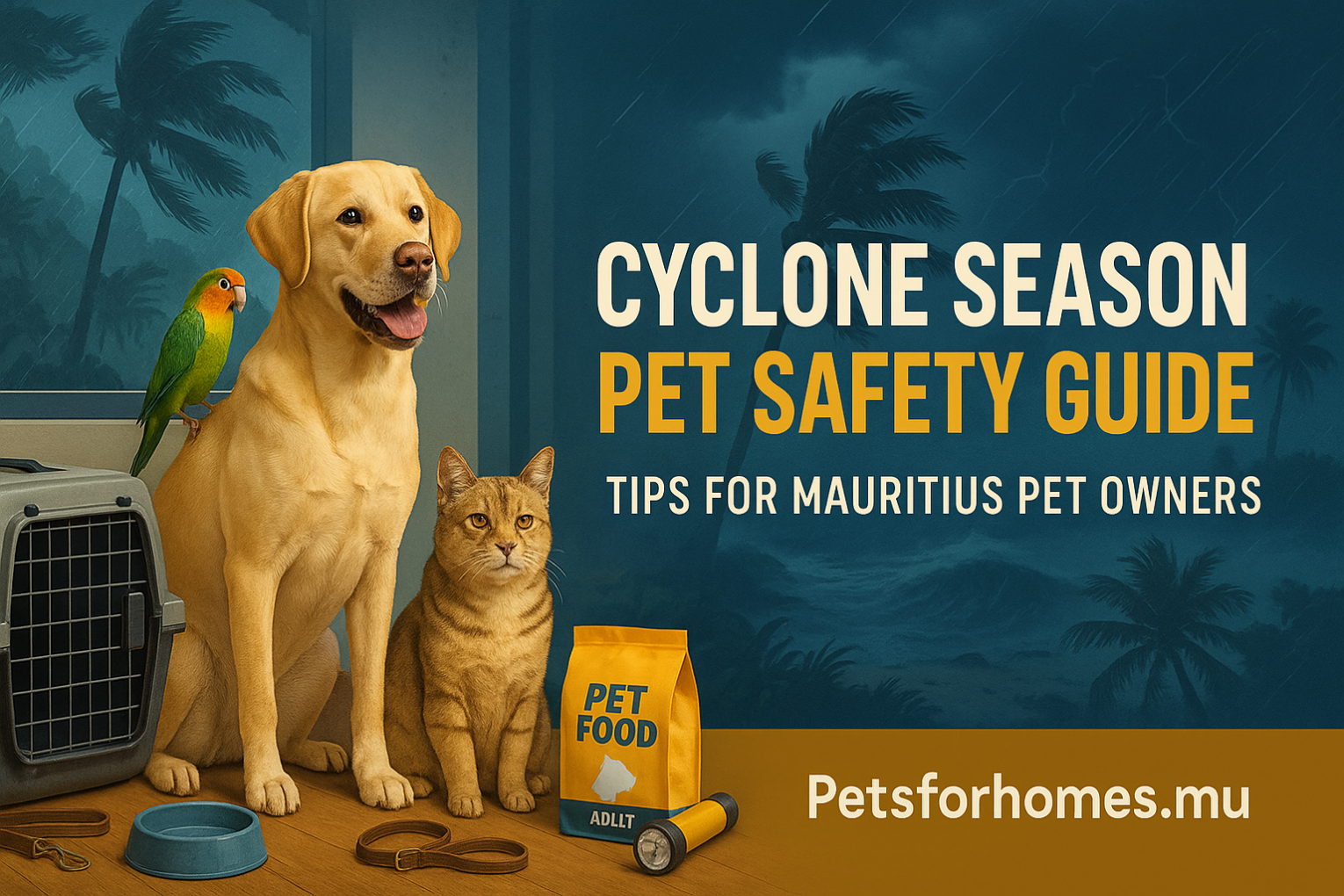
Complete Cyclone Season Pet Safety Guide for Mauritius Pet Owners
As a pet owner in Mauritius, you know that cyclone season preparation isn’t just about securing your home—it’s about ensuring your furry, feathered, and finned family members stay safe during intense tropical storms. Furthermore, with over 2,000 satisfied customers and 5+ years serving the Mauritian pet community, we’ve seen firsthand how proper preparation saves lives during cyclone season.
Moreover, the unique challenges of tropical storms in Mauritius—including power outages lasting days, flooding, and extreme winds exceeding 200 km/h—require specialized knowledge to keep pets safe. Consequently, this comprehensive guide provides everything you need to protect your beloved companions before, during, and after cyclones strike our beautiful island.
Understanding Cyclone Risks for Pets in Mauritius
Mauritius faces an average of 2-3 tropical cyclones annually during our summer months (January-March), with storms capable of reaching Category 5 intensity. Additionally, the combination of our island geography, tropical climate, and urban development creates unique risks for pet safety that mainland pet owners never face.
Primary Hazards Affecting Pets During Cyclones
On the other hand, extended power outages represent the most underestimated threat to pet safety. In fact, our electrical grid typically experiences outages lasting 3-7 days after major cyclones, affecting:
- Aquarium filtration and heating systems (critical for tropical fish)
- Additionally, air conditioning and ventilation (essential for birds and rabbits)
- Furthermore, food preservation and preparation capabilities
- Water pumping systems in many residential areas
Understanding Flooding and Evacuation Challenges
Meanwhile, Mauritius’ rapid urbanization has increased flood risks in low-lying areas, particularly around Port Louis, Beau Bassin, and coastal regions. Therefore, pet owners in these areas must understand evacuation procedures, as emergency shelters rarely accommodate animals.
Local Emergency Resources
Essential Emergency Kit for Every Pet Owner
A properly stocked pet emergency kit should sustain your animals for at least 7 days without external supplies. Based on our experience serving over 2,000 pet owners across Mauritius, here’s your complete preparation checklist:
Food and Water Essentials
🥘 Nutrition Supplies (7-day minimum)
- Dry pet food in waterproof containers (rotate every 3 months)
- Canned/wet food for palatability during stress
- Manual can opener (don’t rely on electric versions)
- Water storage: 4 liters per large dog, 2 liters per cat daily
- Collapsible water bowls for easy storage
- Water purification tablets (safe for pet consumption)
Health and Safety Equipment
🏥 Medical Supplies
- 7-day supply of prescription medications
- Pet first aid kit with gauze, antiseptic, thermometer
- Vaccination records in waterproof container
- Contact information for emergency veterinarians
- Recent photos of your pets (for identification if separated)
- Microchip information and registration details
Species-Specific Emergency Supplies
Different pets require specialized emergency equipment based on their unique physiological needs during tropical storms:
🐕 Dogs & Cats
- Sturdy leashes and harnesses (not just collars)
- Pet carriers rated for transport (airline-approved preferred)
- Comfort items: favorite toys, blankets with familiar scents
- Litter and portable litter box for cats
- Waste bags and cleaning supplies
🐦 Birds
- Secure travel cage (separate from daily cage)
- Cage covers for noise/light protection
- Hand-feeding formula for stress-induced appetite loss
- Battery-powered heating pad for temperature regulation
🐠 Fish & Aquatic Pets
- Battery-powered air pumps (multiple backup units)
- Insulation materials for temperature maintenance
- Water testing kits and treatment chemicals
- Portable containers for emergency relocation
72-Hour Preparation Timeline
Effective cyclone preparation follows a structured timeline based on official weather warnings. Mauritius Meteorological Services issues alerts at specific intervals, and your pet preparation should align with these notifications.
Class I Alert (72 Hours Before Impact)
Immediate Actions (First 24 Hours)
- Verify emergency kit completeness and expiration dates
- Contact veterinary clinics about emergency boarding availability
- Fill all water containers and bathtubs (backup water supply)
- Charge all electronic devices and power banks
- Move outdoor pets to secure indoor locations
- Identify safe rooms in your home (interior, ground floor preferred)
Class II Alert (48 Hours Before Impact)
Critical Preparation Steps
- Test emergency equipment (generators, battery-powered devices)
- Create comfortable confined spaces for each pet
- Begin feeding pets in their designated safe areas
- Remove or secure all outdoor furniture and pet accessories
- Trim trees and shrubs near outdoor enclosures
- Document current condition of all pets (photos, health notes)
Class III/IV Alert (24 Hours Before Impact)
Final Preparation Checklist
- Move all pets to predetermined safe rooms
- Set up feeding stations and waste areas in safe zones
- Secure all windows and eliminate glass hazards
- Place emergency kit supplies in each pet area
- Establish communication plan with family/neighbors
- Turn off main electrical systems if advised
During the Storm: Emergency Safety Protocols
Once cyclone winds exceed 120 km/h, you’re in survival mode. Your preparation pays off now, as leaving safe areas becomes impossible until wind speeds drop below 60 km/h consistently.
Safe Room Management
Your chosen safe room should be on the ground floor, away from large windows, and preferably an interior bathroom or closet. This space becomes home for you and your pets for 6-12 hours during the storm’s passage.
Managing Pet Anxiety During Storms
The combination of noise, pressure changes, and confinement creates extreme stress for animals. Your calm presence is crucial, however, specific techniques help different species:
- First, maintain normal feeding schedules when possible
- Additionally, use familiar comfort items (blankets, toys)
- Furthermore, speak in calm, reassuring tones
- Moreover, avoid punishing fear-based behaviors
- Finally, consider natural calming aids (consult your vet beforehand)
Critical Health Monitoring
Stress-related health issues emerge quickly during cyclones. Therefore, watch for these warning signs requiring immediate intervention:
- Difficulty breathing or excessive panting
- Additionally, vomiting or diarrhea lasting more than 4 hours
- Furthermore, refusal to eat or drink for 12+ hours
- Moreover, seizures or disorientation
- Finally, signs of injury from panic behaviors
Power Outage Emergency Management
Extended power outages pose the greatest long-term threat to pet health. Therefore, prioritize your emergency power resources based on critical needs:
Power Priority System
- Priority 1: Aquarium life support systems (pumps, filters, heaters)
- Priority 2: Medical equipment for pets with health conditions
- Priority 3: Lighting and ventilation for bird enclosures
- Priority 4: Communication devices for emergency contact
- Priority 5: Comfort items (fans, heating pads)
Species-Specific Safety Guidelines
Each type of pet faces unique challenges during tropical storms. Understanding these species-specific risks helps you provide targeted protection that can mean the difference between survival and tragedy.
Dogs: Managing Anxiety and Physical Safety
Dogs experience cyclone stress through multiple sensory channels—they feel barometric pressure changes, hear subsonic wind frequencies, and detect your emotional state. Large breeds face additional challenges in confined spaces, while small dogs are more vulnerable to temperature fluctuations.
- Brachycephalic breeds (bulldogs, pugs): Extra ventilation needed due to breathing difficulties
- Large breeds: Ensure adequate space to prevent injury from panic movements
- Working breeds: Provide mental stimulation to prevent destructive behaviors
- Senior dogs: Monitor for stress-induced health complications more closely
Cats: Hiding Behaviors and Stress Management
Cats’ natural response to stress is hiding, which becomes problematic during emergencies when you need to monitor their health closely. Their sensitive hearing makes them particularly vulnerable to storm noise, and their independent nature can work against safety protocols.
Cat-Specific Emergency Preparations
- Set up litter boxes in multiple locations (cats may refuse unfamiliar areas)
- Provide vertical hiding spaces (cats feel safer when elevated)
- Use pheromone diffusers 48 hours before storm arrival
- Keep familiar bedding and toys in all designated areas
- Monitor eating habits closely (stress can trigger serious health issues)
Birds: Temperature and Noise Sensitivity
Birds are among the most vulnerable pets during cyclones due to their sensitive respiratory systems, temperature regulation challenges, and extreme sensitivity to barometric pressure changes. Their small size means they can quickly develop life-threatening conditions.
Avian Emergency Protocol
- Move birds to interior rooms 48 hours before storm arrival
- Cover cages partially (maintain some light for comfort)
- Provide extra food and water (stress increases consumption)
- Monitor temperature closely (18-24°C optimal range)
- Use battery-powered white noise to mask storm sounds
- Have hand-feeding formula ready for appetite loss
Fish and Aquatic Pets: Life Support Systems
Aquatic pets face the highest mortality risk during extended power outages. Tropical fish species common in Mauritius require consistent temperature and filtration—systems that fail within hours of power loss.
Aquatic Life Support Priority System
- Hour 1-6: Battery-powered air pumps maintain oxygen levels
- Hour 6-24: Reduce feeding to minimize waste production
- Hour 24-48: Partial water changes with stored water
- Hour 48+: Consider temporary relocation to smaller containers
- Emergency option: Transport to friends/family with power
Small Pets: Rabbits, Guinea Pigs, and Hamsters
Small mammals face unique challenges combining the worst aspects of multiple species—they’re sensitive to temperature changes like birds, prone to stress-induced health issues like cats, and require specific environmental conditions like fish.
Small Mammal Emergency Care
- Provide extra bedding for insulation and comfort
- Monitor for GI stasis (life-threatening digestive shutdown)
- Offer favorite foods to encourage continued eating
- Maintain quiet environment (easily stressed by noise)
- Check for overheating (small pets overheat quickly)
After the Storm: Recovery and Health Monitoring
The immediate aftermath of a cyclone often presents more pet health risks than the storm itself. Post-storm hazards include contaminated water sources, debris-related injuries, displaced wildlife, and the stress of returning to normal routines.
Environmental Hazard Assessment
Before allowing pets back into their normal environments, conduct thorough safety inspections. Storm damage creates hidden dangers that can injure or kill pets exploring familiar territory.
- Broken glass and sharp debris in yards and walkways
- Electrical wires that may still be energized
- Contaminated standing water (sewage, chemical runoff)
- Structural damage creating collapse risks
- Poisonous plants and debris from other properties
- Displaced snakes and other dangerous wildlife
Property Safety Inspection Checklist
- Walk entire property looking down for glass/debris
- Check all fencing for damage and escape routes
- Inspect trees for hanging branches or root damage
- Test all electrical systems before reconnecting pet equipment
- Remove any foreign plants or materials blown onto property
- Check water sources for contamination before pet access
Health Monitoring and Veterinary Care
Post-storm health issues often emerge 24-72 hours after the event. The combination of stress, dietary changes, and environmental exposure creates perfect conditions for illness development.
- Digestive problems: Stress-induced diarrhea, appetite loss
- Respiratory issues: Dust, mold, and humidity-related problems
- Behavioral changes: Anxiety, aggression, or withdrawal lasting weeks
- Skin problems: Humidity and contamination-related irritations
- Dehydration: From stress and disrupted drinking patterns
- Days 1-3: Monitor for immediate stress reactions and injuries
- Week 1: Watch for developing health issues from exposure
- Weeks 2-4: Address behavioral changes and anxiety responses
- Month 1+: Return to normal routines and long-term health monitoring
When to Seek Emergency Veterinary Care
Post-storm veterinary services may be limited due to infrastructure damage. Knowing when to seek immediate care versus monitoring at home helps prioritize limited resources.
- Any visible injuries, no matter how minor they appear
- Persistent vomiting or diarrhea lasting more than 24 hours
- Difficulty breathing or rapid/shallow breathing
- Seizures, disorientation, or loss of coordination
- Refusal to eat or drink for more than 24 hours post-storm
- Signs of poisoning (excessive drooling, weakness, collapse)
Restoring Normal Routines
The psychological recovery from cyclone trauma often takes longer than physical healing. Pets thrive on predictable routines, and the faster you can restore normalcy, the better their long-term mental health outcomes.
Routine Restoration Strategy
- Resume normal feeding schedules as soon as safe
- Gradually increase exercise and outdoor time
- Reintroduce favorite activities and social interactions
- Monitor and reward calm behaviors during recovery
- Be patient with regression in training or house habits
- Consider professional behavioral support for severe anxiety
Frequently Asked Questions
🛡️ Protect Your Pets This Cyclone Season
Don’t wait for storm warnings to prepare. Build your emergency kit today with quality supplies from Mauritius’ trusted pet experts.
Shop Emergency Supplies Find Emergency VetsFree delivery over Rs1200 | Serving 2000+ pet owners across Mauritius since 2020


